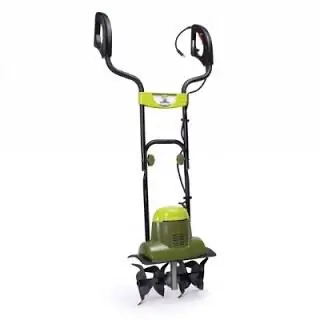2025 Author: Howard Calhoun | [email protected]. Last modified: 2025-01-24 13:10:43
Tillage before sowing is a critical part of agrotechnical measures, the purpose of which is to create a finely cloddy layer on the surface of the earth. To perform this function, a special technique with a certain set of working bodies is used. In particular, such tasks are solved by a pre-sowing cultivator provided with units and mechanisms for coupling with tractors.
Purpose of the unit

The equipment is used to prepare fertile soil layers for sowing various crops, including corn, flax, beets, soybeans, etc. As part of this preparation, the cultivator implements a set of tasks, including loosening, moisture incorporation, fallow care, the formation of a bed for seeds. Different models have their own set of possibilities, but the main thing is the operation of layer-by-layer crumbling of the top layer of the earth with additional compaction and leveling effects. At the same timeseedbed cultivators are subject to severe restrictions on use. This applies to certain indicators of soil moisture, field slope, rockiness and soil density. In order to save equipment and maintain its functionality at the proper level, manufacturers do not recommend using these tools on problem surfaces or for non-target tasks.
Basic design of seedbed cultivator

This technical tool can be considered as an attachment with a wheeled part, but without its own drive system. Most cultivators of this type are aggregated with tractor equipment in order to form a full-fledged running gear. The design of the cultivator is a block-modular predominantly metal device based on a frame platform. Equipment for fastening wheels and fixing units for working bodies is usually installed on the main carrier frame. The configuration of the placement of the latter may be different, but from the point of view of the relationship with the carrier platform, it is worth emphasizing the prevalence of segment structures.
Such cultivators for seedbed preparation provide for the possibility of transforming the frame base in order to supplement the side working modules. Docking and control of functional units is carried out by means of hydraulic cylinders powered by the tractor's hydraulic system.
Work items

To startIt is worth emphasizing the important function that auxiliary equipment performs. It includes mounting posts, levelers and positioners. With the help of these components, you can remove and install processing tools, adjust them in height / depth and other parameters. As for the working bodies directly, the standard configuration of the pre-sowing cultivator includes:
- Arrowed paws. Usually bolted and quick-detachable devices up to 300-350 mm wide are used. Implement deep processing (including chisel), while not leaving ridges and furrows.
- Usually, the legs are followed by a plank-tooth module to eliminate the remaining irregularities. It can perform micro-relief correction, surface loosening, block breaking, and some modifications also distribute crop residues (mulching).
- Power harrow. Designed for deep crumbling of the soil at the level of sowing and subsequent extraction of weed shoots to the surface of the earth.
If we talk about operating parameters, then a typical cultivator captures a strip 3-5 m wide with a maximum depth of 20-30 cm. The travel speed varies from 15 to 20 km/h on average.
Extended equipment

The quality of the unit depends on many operational factors. Optional devices allow you to pinpoint the negative nuances and stimulate the positive effects of using the cultivator. While many of the add-ons are increasingly being introducedin the basic equipment delivery sets. In particular, the Lemken pre-sowing cultivator in the Kristall modification is equipped with an innovative system for changing working bodies, which makes it possible to quickly rebuild the configuration of the shares, taking into account the current requirements for cultivation tactics.
In addition, these models are equipped with hydraulic blocking, guide plates (on the sides), pneumatic seed drill, etc. Also, modern designs are provided with hydropneumatic accumulators that reduce shock loads on the bearing part and wheels. The working pressure of hydraulic cylinders in such mechanisms reaches 130-150 kg/cm2.
Cultivator maintenance
Manufacturers recommend a set of maintenance activities once a month. Among the main technical support measures for seedbed cultivators are the following:
- Cleaning the surfaces of the structure from dirt, dust and vegetation residues.
- During a visual inspection, the condition of the unit, the quality of fastening of the components, the correct setting of working tools, and the reliability of the connections are checked.
- Perform adjustment operations according to current processing needs.
- Lubrication of working units and parts. In particular, transport wheels, support bearings, connecting equipment, rotary rollers, frames, hydraulic cylinders, etc. are treated with technical fluid.
Conclusion

The tillage system before sowing is still not the most difficult work in terms of execution technology. To prepare the soil, sometimes the simplest agricultural tools are enough. Nevertheless, the seedbed cultivator is an indispensable technical tool used by large agricultural enterprises. Along with the quality and high speed of tillage, the user gets the opportunity to optimize organizational efforts by performing several operations within the same workflow. Ultimately, the multitasking and functionality of such cultivators becomes the key to economic benefits from their use.
Recommended:
Job description of the sales floor controller: duties, job description and requirements

There are hundreds of different professions, and the sales floor controller is one of them. This profession can hardly be called prestigious. They don’t dream about it, starting from the school bench. But it is one of the basic ones. The work of its representatives is not so noticeable and obvious, but it is beneficial for society. Let's learn more about the job responsibilities of a sales floor controller and other features of this profession
Job description of a psychologist - duties, job description and requirements

Not every person knows the duties of a psychologist. Many have a hard time imagining what this specialist does. What are the requirements for it in various organizations. What rights does a psychologist have? Who is suitable for this profession
Product description: an example of how to write a detailed description, write a business plan

If you could not find a business plan with a description, characteristics of the product that you plan to promote, then you need to start compiling it yourself. What sections does a business plan include? What are the stages in its preparation? And finally, how to arouse sincere interest among investors? All these and other equally interesting questions will be discussed in the article
Are you interested in cultivators? Reviews and opinions of those who have evaluated this technique will help you make the right choice

If the upcoming spring work scares you, makes you sad with memories of back pain or joint pain, buy assistants. The best of them are cultivators
Disk cultivators: characteristics and description

To obtain a large and high-quality harvest, it is necessary to take care of the competent processing of the fertile layer of the earth. In achieving this goal, disk cultivators, which are one of the most popular types of agricultural equipment, will be of great help

